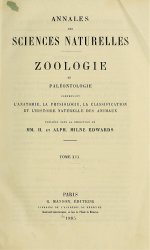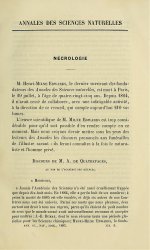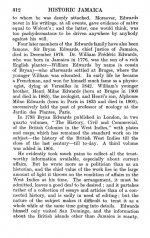Milne-Edwards, Alphonse (1835-1900), son père Henri et leurs proches
Familles Milne-Edwards et Trézel
Le nom de Milne-Edwards1 est mentionné dans les lettres à partir de 1858, d’abord au titre de relation professionnelle d’André Marie Constant Duméril (dont Henri Milne-Edwards prononce le discours aux funérailles le 16 août 1860), plus tard quand Alphonse Milne-Edwards devient membre de la parenté des Mertzdorff.
*
Henri Milne-Edwards (1800-1885) est né à Bruges, du second mariage de l’anglais William Edwards (1746-1823) avec Elisabeth Vaux (qui, elle, est française), riche planteur de la Jamaïque qui a eu plusieurs autres enfants de sa première union. William Edwards, qui aide des Britanniques à rejoindre leur pays, est arrêté par les troupes de Napoléon (il ne revient s’installer définitivement à Paris qu’en 1814). Henri Milne-Edwards est alors pris en charge à Paris par son frère aîné William Frederic Edwards (1777-1842), auditeur de Lamarck, médecin, botaniste, ethnologue (il fonde la Société ethnologique de Paris en 1838).
Henri prend la nationalité française, étudie la médecine et obtient son doctorat en 1823. Il suit les cours de Georges Cuvier (1769-1832) et se lie d'amitié avec Jean Victor Audouin (1797-1841). C'est avec ce dernier qu'il réalise entre 1826 et 1828 une étude détaillée de la faune marine côtière des environs de Granville. En 1832, il participe, comme membre fondateur, à la création de la Société entomologique de France et devient professeur d’histoire naturelle à l’Ecole centrale des arts et manufactures et au lycée Henri IV. Docteur ès sciences en 1836, membre de l’Institut en 1838, Henri Milne-Edwards devient, la même année, aide naturaliste de la chaire d’histoire naturelle des crustacés, des arachnides et des insectes ou des animaux articulés au Muséum avant d’être nommé professeur en 1841, à la mort d’Audouin. En 1844, il devient professeur de zoologie et de physiologie comparées à la faculté des sciences de Paris. Pédagogue émérite, il offre un enseignement attractif, en s’appuyant sur des démonstrations pratiques. En 1862, il succède à Isidore Geoffroy-Saint-Hilaire (1805-1861) à la chaire de mammalogie du Muséum, qu’il quitte en 1876 afin de se consacrer pleinement à ses responsabilités au sein de la faculté des sciences dont il est devenu le doyen trois ans plus tôt.
Henri Milne-Edwards innove en alliant l’anatomie comparée de Georges Cuvier avec la physiologie. Dans son Introduction à la zoologie générale ou Considérations sur les tendances de la nature dans la constitution du règne animal (1851) il développe une théorie de la « division du travail physiologique » : les animaux inférieurs, constitués d’un seul type de tissu, remplissent toutes les fonctions vitales tandis que les animaux supérieurs, dont chaque tissu est spécialisé (nutrition, respiration, …) ne peuvent pas se reconstituer. La plupart de ses travaux sont publiés dans les Annales des sciences naturelles, dont il dirige la partie consacrée à la zoologie à partir de 1834. Il publie des manuels à l’usage des collèges. Parmi ses très nombreux ouvrages, on peut mentionner :
Recherches anatomiques et physiologiques sur la circulation dans les crustacés (en 1827) dont Georges Cuvier et André Marie Constant Duméril donnent un rapport à l'académie royale des sciences ; Histoire naturelle des crustacés (1834-1840), qui demeure longtemps un ouvrage de référence ; Leçons sur la physiologie et l'anatomie comparée de l'homme et des animaux (14 volumes, 1857-1881).
En 1823, Henri Milne-Edwards épouse Laure Trézel (1801-1842), fille du général Camille Alphonse Trézel (1780-1860). Une « Mme Trézel » est citée dans les lettres, qui est probablement Auguste Maxence Lemire, veuve de Camille Alphonse Trézel, décédée le 10 décembre 1886, à l'âge de 96 ans ; à ce moment elle est déclarée rentière, demeurant au 14 rue Cuvier, fille de Louis Auguste Lemire et de Geneviève Perrette Cerveau.
Une autre « Mme Trézel » ou « Mme Trézel (Camille) », est citée ; il s’agit alors probablement de Louise Ida Martineau qui épouse Antoine Camille (Félix) Trézel en 1872. Antoine Camille (Félix) Trézel, né en 1840, fait des études au lycée Napoléon. La nature des liens familiaux qui lient ces Trézel n’est pas établie.
*
Le couple Henri Milne-Edwards-Laure Trézel a neuf enfants, dont quatre seulement survivent :
- Julie Milne-Edwards (1831-1857) épouse Ernest Charles Jean Baptiste Dumas (1827-1890) ; ils ont deux enfants, Noël Dumas (1854-1943) et un fils (1856-1863). Dans une lettre du 29 novembre 1863 Eugénie Desnoyers fait allusion à la mort de cet enfant malade dont Cécile Milne-Edwards, sa tante et belle-mère, prenait soin, car Julie étant décédée à l’âge de 26 ans, Ernest Charles Jean Baptiste se remarie avec Cécile, sœur de Julie.
- Cécile Milne-Edwards (1832-1917) épouse à Paris, le 8 décembre 1862, son beau-frère veuf, Ernest Charles Jean Baptiste Dumas (1827-1890) ; ils ont un seul enfant, Jean Dumas (1865-1907).
- Louise Milne-Edwards (1834-1910) épouse Daniel Pavet de Courteille, cinquième enfant de Charles Pavet de Courteille (1788-1868) et de Sophie Silvestre de Sacy (1793-1877) ; ils ont 8 enfants dont Marthe Pavet de Courteille (1864-1946).
- Alphonse Milne-Edwards (1835-1900) épouse en 1862 Aglaé Desnoyers (1839-1887) ; le couple n’a pas d’enfant, mais est amené à prendre en charge Marie et Emilie Mertzdorff après la mort en 1873 d’Eugénie Desnoyers, seconde épouse de Charles Mertzdorff.
*
Alphonse Milne-Edwards (1835-1900) suit les traces paternelles. Il obtient le titre de docteur en médecine en 1860 à Paris (avec sa thèse : Etudes chimiques et physiologiques sur les os), de docteur ès sciences en 1861. Il est nommé aide-naturaliste au Muséum d'histoire naturelle en 1862. Agrégé de l'Ecole supérieure de pharmacie en 1864, il devient professeur titulaire de zoologie à l'école de pharmacie (1865), directeur adjoint du laboratoire de zoologie de l'École des hautes études en 1869, et directeur en 1880. En 1876 il succède à son père au Muséum (chaire d'ornithologie et de mammalogie), institution dont il assure la direction à partir de 1891. Il est membre de l’Académie des sciences (1879), membre de la Société d’Anthropologie, membre de l'Académie de médecine (1885), président de la Société de géographie (1897-1900).
Ses premiers travaux se rapportent à la physiologie médicale ; il publie ensuite des ouvrages sur l'anatomie des mammifères, la zoologie en général et la paléontologie : Recherches anatomiques et paléontologiques pour servir à l'histoire des oiseaux fossiles de la France (quatre volumes, 1867-1871) et Observations anatomiques sur quelques mammifères de Madagascar (avec Alfred Grandidier, 1867). Il conduit plusieurs missions destinées à explorer la population zoologique des profondeurs marines (1880-1883), dans le golfe de Gascogne puis aux Canaries, aux îles du Cap-Vert et aux Açores. Ces travaux sont récompensés par la médaille d'or de la Royal Geographical Society. Il effectue également des recherches sur l'hippopotame du Liberia et des études sur la faune de la Chine, du Tibet oriental, ou encore du Mexique.
Notes
1 À l'origine, Milne était l'un des prénoms de Henri Edwards. Afin d'éviter d'être confondu avec l'un des membres de son importante famille, il accole celui-ci à son nom de famille ; la forme internationale de son nom est « Milne-Edwards ».
Notice bibliographique
Pour citer ce document
«Milne-Edwards, Alphonse (1835-1900), son père Henri et leurs proches», correspondancefamiliale [En ligne], Compléments historiographiques, Biographies, M,mis à jour le : 19/09/2013








